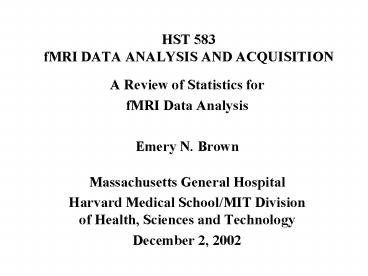HST 583 fMRI DATA ANALYSIS AND ACQUISITION - PowerPoint PPT Presentation
Title:
HST 583 fMRI DATA ANALYSIS AND ACQUISITION
Description:
Harvard Medical School/MIT Division of Health, Sciences ... iv) hemoglobin and deoxy hemoglobin content. Noise. Stochastic. i) physiologic. ii) scanner noise ... – PowerPoint PPT presentation
Number of Views:60
Avg rating:3.0/5.0
Title: HST 583 fMRI DATA ANALYSIS AND ACQUISITION
1
HST 583 fMRI DATA ANALYSIS AND ACQUISITION
- A Review of Statistics for
- fMRI Data Analysis
- Emery N. Brown
- Massachusetts General Hospital
- Harvard Medical School/MIT Division of Health,
Sciences and Technology - December 2, 2002
2
Outline
- What Makes Up an fMRI Signal?
- Statistical Modeling of an fMRI Signal
- Maxmimum Likelihoood Estimation for fMRI
- Data Analysis
- Conclusions
3
THE STATISTICAL PARADIGM (Box, Tukey) Question
Preliminary Data (Exploration Data
Analysis) Models Experiment
(Confirmatory
Analysis) Model Fit Goodness-of-Fit
not satisfactory Assessment
Satisfactory Make an Inference Make
a Decision
4
Case 3 fMRI Data Analysis Question Can
we construct an accurate statistical model
to describe the spatial temporal patterns of
activation in fMRI images from visual and
motor cortices during combined motor and
visual tasks? (Purdon et al., 2001 Solo et al.,
2001)
A STIMULUS-RESPONSE EXPERIMENT
Acknowledgements Chris Long and Brenda Marshall
5
(No Transcript)
6
What Makes Up An fMRI Signal? Hemodynamic
Response/MR Physics i) stimulus
paradigm a) event-related b) block ii)
blood flow iii) blood volume iv)
hemoglobin and deoxy hemoglobin content Noise
Stochastic i) physiologic ii) scanner
noise Systematic i) motion artifact ii)
drift iii) distortion iv)
registration, susceptibility
7
Physiologic Response Model Block Design
8
Gamma Hemodynamic Response Model
9
Physiologic Model Event-Related Design
10
Physiologic Model Flow, Volume and Interaction
Terms
11
Scanner and Physiologic Noise Models
12
DATA
The sequence of image intensity measurements on a
single pixel.
13
fMRI Signal and Noise Model
Measurement on a single pixel at time
Physiologic response
Activation coefficient
Physiologic and Scanner Noise
for
We assume the
are independent, identically distributed
Gaussian random variables.
14
fMRI Signal Model
Physiologic Response
hemodynamic response
input stimulus
Gamma model of the hemodynamic response
Assume we know the parameters of g(t).
15
MAXIMUM LIKELIHOOD
Define the likelihood function
, the joint
probability density viewed as a function of the
parameter
with the data
fixed. The maximum likelihood estimate
of
is
That is,
is a parameter value for which
attains a maximum as a function of
for fixed
16
ESTIMATION
Joint Distribution
Log Likelihood
Maximum Likelihood
17
GOODNESS-OF-FIT/MODEL SELECTION
An essential step, if not the most essential step
in a data analysis, is to measures how well the
model describes the data. This should be
assessed before the model is used to make
inferences about that data. Akaikes
Information Criterion
For maximum likelihood estimates it measures the
trade-off between maximizing the likelihood
(minimizing
)
and the numbers of parameters
the model requires.
18
GOODNESS-OF-FIT
- Residual Plots
- KS Plots
We can check the Gaussian assumption with our K-S
plots.
Measure correlation in the residuals to assess
independence.
19
EVALUATION OF ESTIMATORS
an estimator of
based on
Given
Mean-Squared Error
Bias
Consistency
Efficiency Achieves a minimum variance
(Cramer-Rao Lower Bound)
20
FACTOIDS ABOUT MAXIMUM LIKELIHOOD ESTIMATES
- Generally biased.
- Consistent, hence asymptotically unbiased.
- Asymptotically efficient.
- Variance can be approximated by minus the inverse
of the Fisher - information matrix.
- If
is the
estimate of
then
is the
estimate of
21
Cramer-Rao Lower Bound
CRLB gives the lowest bound on the variance of an
estimate.
22
CONFIDENCE INTERVALS
The approximate probability density of the
maximum
likelihood estimates is the Gaussian probability
density with mean
and variance
where
is the Fisher
information matrix
An approximate confidence interval for a
component of
is
23
THE INFORMATION MATRIX
24
CONFIDENCE INTERVAL
25
(No Transcript)
26
Kolmogorov-Smirnov Test White Noise Model
27
White Noise Model Pixelwise Confidence Intervals
for the Slice
28
fMRI Signal and Noise Model 2
Measurement on a single pixel at time
Physiologic response
Activation coefficient
Physiologic and Scanner Noise
for
We assume the
are correlated noise AR(1)
Gaussian random variables.
29
Simple Convolution Plus Correlated Noise
30
Kolmogorov-Smirnov Test Correlated Noise Model
31
Correlated Noise Model Pixelwise Confidence
Intervals for the Slice
32
AIC Difference AIC Colored Noise-AIC White Noise
33
fMRI Signal and Noise Model 3
Measurement on a single pixel at time
Physiologic response
Physiologic and Scanner Noise
for
We assume the
are independent, identically distributed
Gaussian random variables.
34
Harmonic Regression Plus White Noise Model
35
AIC Difference Map AIC Correlated Noise-AIC
Harmonic Regression
36
Conclusions
- The white noise model gives a good description of
the hemodynamic response - The correlated noise model incorporates known
physiologic and biophysical properties and hence
yields a better fit - The likelihood approach offers a unified way to
formulate a model, compute confidence intervals,
measure goodness of fit and most importantly
make inferences.































